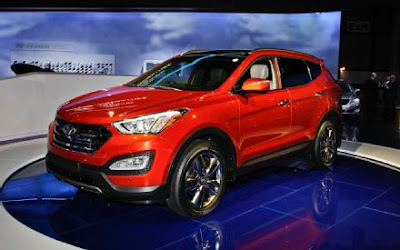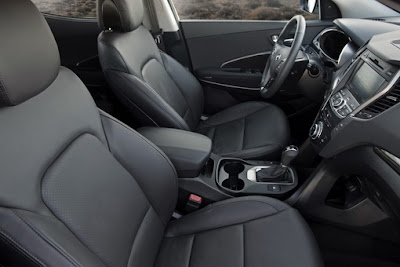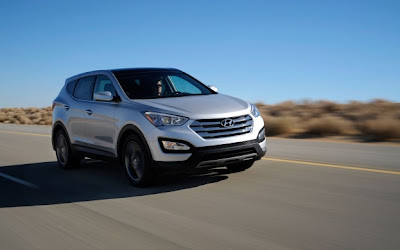AUTO SHOWS: Rumors about the return of the seven-passenger Hyundai Santa Fe
have been floating around for quite a while. While we expected the 2013 Santa Fe
midsize crossover to grow in just about every dimension to better fit a third
row, Hyundai is also debuting the 2013 Santa Fe Sport, a smaller five-passenger
model with an optional turbocharged four-cylinder engine.
The two Santa Fes don't share a single powerplant. The shorter Santa Fe
Sport goes for an all four-cylinder lineup, starting with a 2.4-liter 190 hp I-4
making an estimated 181 lb-ft of torque. The optional powerplant is Hyundai's
now familiar 2.0-liter turbocharged I-4, which produces 264 hp and 269 lb-ft of
torque under the hood of the Santa Fe Sport 2.0T. The 8.5-inch longer Santa Fe
gets a slightly more potent engine -- the 3.3-liter 290-hp V-6 ripped straight
from the new Azera. All three engines are hooked up to a six-speed automatic
transmission. Front-wheel drive is standard, while all-wheel drive with torque
vectoring is available.
Fuel economy was a major focus with the 2013 Santa Fe and Santa Fe Sport.
Though larger than before, thanks to the increased use of lightweight
high-tensile steel, curb weight has dropped but fuel economy, for the most part,
has improved. Hyundai expects front-drive Santa Fe Sports equipped with the
2.4-liter I-4 to achieve 23/33 mpg city/highway, and front-drive turbo models to
get 23/31 mpg. Hyundai expects the V-6-powered Santa Fe to score 19/26 mpg in
EPA testing. For comparison, the outgoing Santa Fe scored 20/28 mpg with the
I-4, and 20/26 mpg with the V-6. All 2013 Santa Fes come standard with Hyundai's
Active ECO system.
Hyundai incorporated a few new driver-oriented technologies into the new
Santa Fe and Santa Fe Sport, including its new all-wheel-drive system with
Torque Vectoring Cornering Control, or TVCC for short. Hyundai's TVCC can
distribute torque as needed to any single wheel at any time, allowing the system
to reduce unwanted understeer or oversteer.
Hyundai is seeking to improve steering feel with its new Driver
Selectable Steering Mode (DSSM) system on the Santa Fe and Santa Fe Sport. DSSM
includes three operating modes - Comfort, Normal, and Sport - that can lower or
raise steering effort depending on the mode. DSSM adjusts not only the
assistance level, but also the on-center and in-curve build-up feel, which
Hyundai says will offer "a very natural progressive feel." We'll have to wait
and see on that one.
As for styling, the Santa Fe and Santa Fe Sport wear Hyundai's new "Storm
Edge" design language. Up front, both Santa Fe models feature Hyundai's large
trapezoidal chrome grille with three bars on the Santa Fe Sport and four bars on
the Santa Fe. The headlights visually link the Santa Fe to the new Genesis Coupe
and Veloster. The Santa Fe and Santa Fe Sport's lower front fascia features a
faux aluminum skid plate flanked by two foglights, which have LED daytime
running lights.
The Santa Fe Sport and longer Santa Fe stylistically diverge in the
profile and rear views. The window line arches up aggressively, giving the Santa
Fe Sport a small window behind the rear passengers. The Santa Fe has a less
aggressive beltline and a larger window behind the second row.
Out back the larger Santa Fe has dual exhaust and large taillights. The
Santa Fe Sport gets a more aggressive taillight design, and a twin-tipped
exhaust that exits on the right side of the car. The base Santa Fe Sport rides
on 17-inch wheels, while Santa Fe Sport 2.0Ts gets 19-inch wheels. The Santa Fe
rides on either 18- or 19-inch wheels.
The interior of the two Santa Fes have a flowing center stack that's
typical of Hyundai. Both models offer Hyundai's third-generation navigation
system on a multifunction eight-inch touch-screen display. Hyundai's Blue Link
service (think OnStar) is standard on all Santa Fe models, while the
long-wheelbase Santa Fe gets blind spot detection. Other available features
include a panoramic sunroof, push-button start with keyless entry, and heated
seats front and rear.
Some of the more functional interior amenities include a second row that
folds flat and splits 40:20:40, and is available with the ability to slide fore
and aft. The three-row Santa Fe boosts 1.9 inches more second row legroom than
the Santa Fe Sport. The Santa Fe's third row is split 50:50, can fold flat into
the floor, and offers 31.5 inches of legroom.
The short-wheelbase 2013 Hyundai Santa Fe Sport will go on sale in July.
Those looking for seven-passenger utility will have to wait until January 2013
to get their hands on the larger Santa Fe, which replaces the oft-forgotten
Veracruz in Hyundai's lineup. Pricing hasn't yet been announced, but expect the
2013 Santa Fe Sport to start around $25,000, and the 2013 Santa Fe to carry a
base price closer to $30,000.
2013 Hyundai Santa Fe Sport and Santa Fe
BASE PRICE: $25,000-$28,500 (est)
VEHICLE LAYOUT: Front-engine, FWD/AWD, 5-7 pass, 4-door SUV
ENGINES: 2.4L/190-hp/181-lb-ft DOHC 16-valve I-4; 2.0L/264-hp/269-lb-ft turbocharged DOHC 16-valve I-4; 3.3L/290-hp/255-lb-ft DOHC 24-valve V-6*
TRANSMISSION: 6-speed automatic
CURB WEIGHT: 3450-4000 lb (mfr)
WHEELBASE: 106.3 in (Sport); 110.2 in. (LWB)
LENGTH X WIDTH X HEIGHT: 184.6 x 74.0 x 66.1 in (Sport); 193.1 x 74.2 x 66.5 in
0-60 MPH: 7.0-9.5 sec (est)
EPA CITY/HWY FUEL ECON: 0.73-0.90 lb/mile
ENERGY CONSUMPTION, CITY/HWY: 0.73-0.90 lb/mile
CO2 EMISSIONS: 147-177/102-130 kW-hrs/100 miles
ON SALE IN U.S.: 147-177/102-130 kW-hrs/100 miles
July 2012 (Sport); January 2013 (LWB)
View the original article here

















